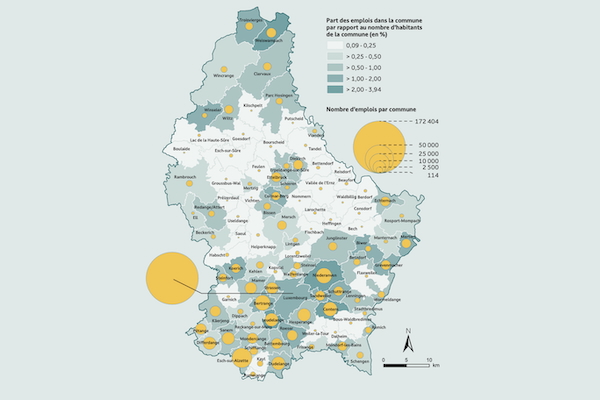 Percentage share of jobs in each municipality of Luxembourg, in relation to the number of inhabitants in each municipality;
Credit: ODT, LISER
Percentage share of jobs in each municipality of Luxembourg, in relation to the number of inhabitants in each municipality;
Credit: ODT, LISER
On Tuesday 13 May 2025, Luxembourg’s Ministry of Housing and Spatial Planning, the Department of Spatial Planning (DATer) and the Luxembourg Institute of Socio-Economic Research (LISER) shared statistics on employment and mobility in the Grand Duchy.
In a press release, they reported that in 2023 Luxembourg recorded nearly 500,000 jobs, resulting in an employment-to-population ratio of 0.76 - the highest among European countries (excluding Monaco).
The statistics are taken from the latest edition of the “Maps and Figures” series, published by the Observatory for Territorial Development (ODT), which provided a detailed analysis of job distribution, workers’ places of residence and commuting flows. The publication indicated that Luxembourg has continued to distinguish itself through a dynamic labour market and strong appeal for cross-border workers.
According to the study, Luxembourg residents occupy more than 53% of jobs, while cross-border workers hold 47%, with most of those commuting from France (52.7%), Belgium (23.7%) and Germany (23.6%).
The study shows that only 24.3% of workers are employed in their town of residence, highlighting the scale of commuting flows. On average, Luxembourg residents travel 16.7km to work, while cross-border workers face significantly longer journeys: 44.7km for French workers; 48km for German workers; and 53.9 km for Belgian workers. In 2023, Luxembourg employed 216,522 cross-border workers. The capital city employed the highest number (62,295), followed by Esch-sur-Alzette (10,148), Bertrange (7,570) and Leudelange (5,730). Several border towns recorded particularly high proportions of jobs filled by cross-border workers, including Weiswampach (70%), Grevenmacher (60%) and Schengen (67%).
The City of Luxembourg remains the country’s economic core, accounting for more than one-third of all national jobs. The Agglo-Centre area, which includes Bertrange and Niederanven, holds over 50% of employment.
The press release noted that the high concentration of jobs and the prominence of cross-border employment raises major challenges in mobility and urban planning. Despite investments in public transport (including tramway expansion and free travel), road congestion and long daily commutes remain critical issues.
In response to the findings, authorities suggested a number of strategic measures:
⁃ promote the decentralisation of employment to other national and cross-border economic hubs;
⁃ encourage remote working and co-working to reduce commuting;
⁃ strengthen cross-border cooperation by improving infrastructure and transport service planning.
The ODT is an initiative of the DATer, under the Ministry of Housing and Spatial Planning. LISER implements this initiative. The ODT analyses Luxembourg’s territorial dynamics to enhance understanding of development mechanisms and assess the effectiveness of public policies in this area. It serves both as a decision-making tool for public authorities and a communication platform for the wider public.








